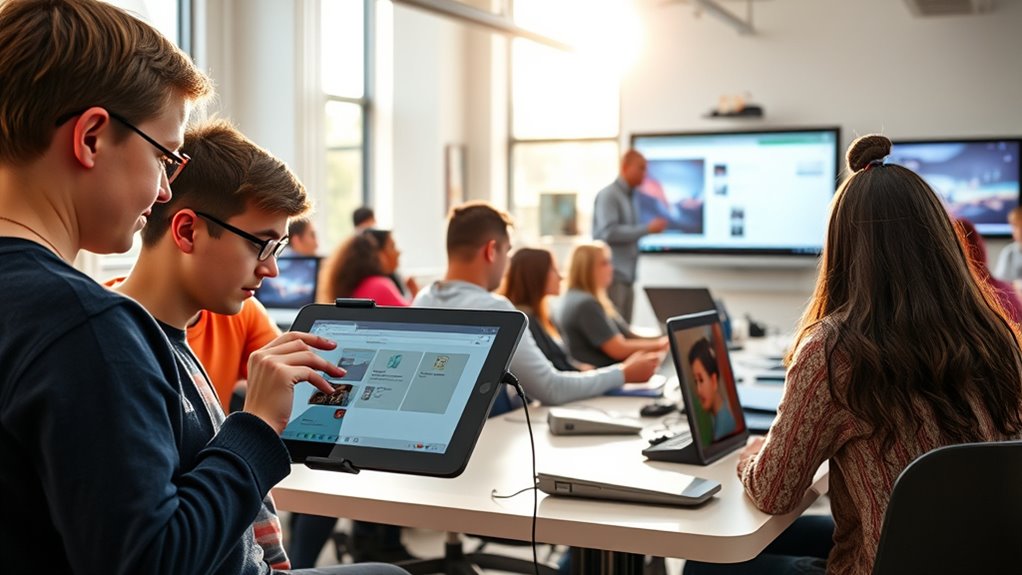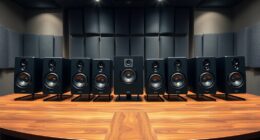In seven days, you can go from beginner to pro by focusing on core concepts, exploring different types of assistive devices, and understanding key terminology. Start by learning how tools support independence and accessibility, then practice using common technologies like mobility aids and communication tools. Stay updated on the latest innovations and develop hands-on skills for implementation and troubleshooting. Keep exploring, and you’ll discover even more ways to master assistive tech effectively.
Key Takeaways
- Start with foundational knowledge of assistive technology principles, including core concepts, types, and user-centered design.
- Conduct comprehensive needs assessments to personalize device selection and ensure relevance to individual routines and environments.
- Engage in hands-on practice with various tools, focusing on sensory integration, troubleshooting, and environmental modifications.
- Stay informed about emerging innovations by following industry updates, webinars, and expert communities.
- Develop skills in user support, emotional awareness, and environmental adaptations to promote independence and confidence.
Understanding the Foundations of Assistive Technology
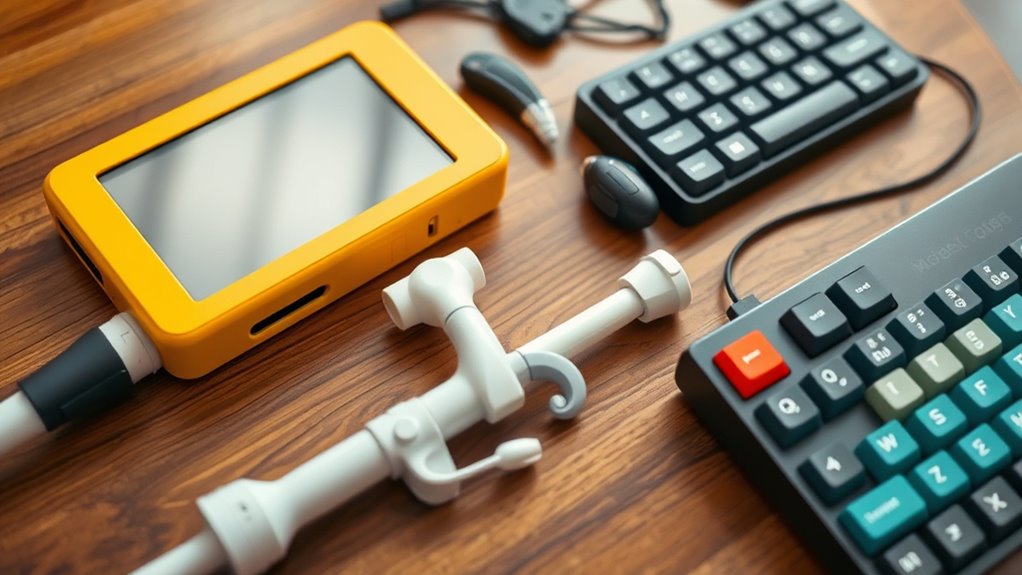
Assistive technology refers to tools and devices designed to help individuals with disabilities perform daily tasks more independently. At its core, understanding assistive tech involves recognizing adaptive interfaces that modify how users interact with technology, making it more accessible. User-centered design plays a vital role, ensuring that devices are tailored to meet the specific needs of users, rather than forcing users to adapt to technology. This approach prioritizes usability, comfort, and efficiency, leading to better outcomes. When you focus on adaptive interfaces and user-centered design, you create solutions that are intuitive and empowering. Recognizing the importance of color accuracy in assistive devices can significantly improve the effectiveness of visual aids. These foundational principles make assistive technology more effective, fostering independence and improving quality of life for those who rely on it.
Exploring Different Types of Assistive Devices and Tools
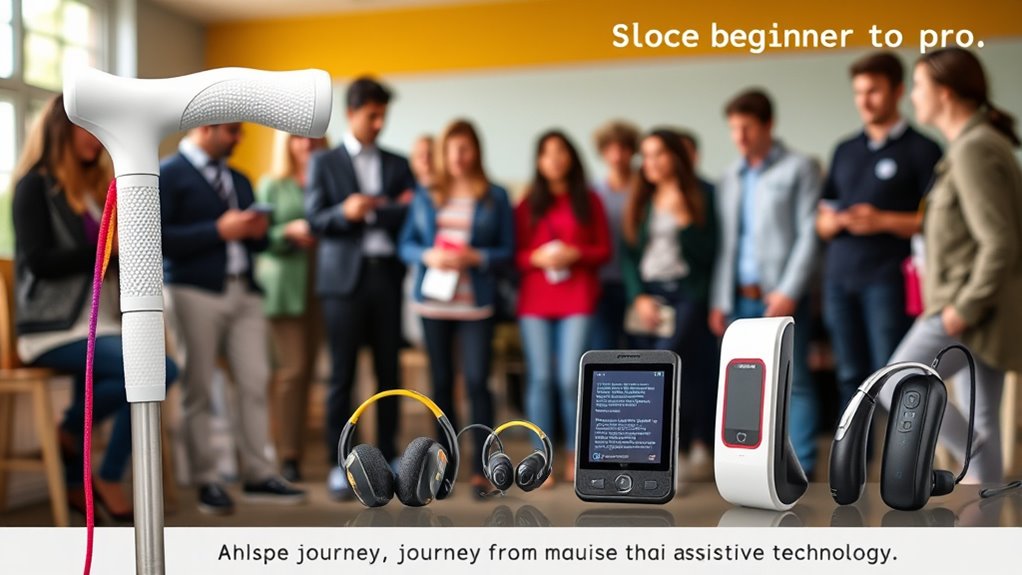
There are many assistive devices and tools designed to support different needs. You might use mobility aids, visual or hearing aids, or communication technologies to improve daily life. Exploring these options can help you find the best solutions for your unique situation. For example, understanding essential oils for health support can offer additional natural remedies to complement assistive devices.
Mobility Assistance Devices
Mobility assistance devices have revolutionized the way individuals with movement challenges navigate their environments, offering greater independence and safety. These devices include wheelchairs, scooters, and walkers, tailored to meet diverse needs. Adaptive seating plays a vital role, providing comfort and proper support during movement. You can customize wheelchairs with accessories like cushions, armrests, or storage options to enhance functionality and comfort. Wheelchair accessories help you stay organized and improve your overall experience. Some devices incorporate lightweight frames for ease of use, while others feature advanced controls for better maneuverability. By choosing the right mobility aid, you gain confidence and autonomy in daily activities, making your environment more accessible and your life more manageable. Understanding city dynamics can also help you adapt more effectively to new environments and ensure a smoother transition.
Visual and Hearing Aids
Building on mobility devices that help you move more freely, visual and hearing aids open new avenues for communication and perception. These assistive tools enhance your ability to see, hear, and interpret the world around you. Visual aids include items like magnifiers, screen readers, and specialized glasses that boost clarity and detail. Hearing devices range from cochlear implants to lightweight hearing aids that amplify sounds effectively. Imagine a world where you can: – Read text easily with advanced screen magnifiers – Clearly hear conversations with discreet hearing devices – Use visual aids for better reading and viewing experiences support overall health benefits.
Communication Technologies
Have you ever wondered how technology can bridge communication gaps for people with speech or hearing challenges? Communication technologies like augmentative communication devices and speech synthesis tools empower individuals to express themselves effectively. These tools range from simple picture boards to sophisticated speech-generating devices. They help users convey messages, share ideas, and participate actively in conversations. To understand better, here’s a quick overview:
| Device Type | Functionality | Ideal User |
|---|---|---|
| Speech Synthesis | Converts text into spoken words | Non-verbal speakers |
| Augmentative Devices | Enhances existing communication | Speech-impaired users |
| Hearing Aids | Amplifies sounds | Hearing-impaired users |
| Captioning Tech | Displays real-time text | Hearing challenges |
| Communication Apps | Facilitates messaging | All users needing support |
These tools make communication accessible and inclusive, transforming lives daily. Additionally, understanding the assistive technology involved can help in selecting the most suitable device for each individual’s needs.
Learning Key Terms and Concepts in Assistive Tech

Understanding key terms and core concepts is essential to mastering assistive technology. These definitions help you communicate effectively and choose the right tools for specific needs. Let’s explore the essential assistive terms that form the foundation of this field.
Essential Assistive Terms
What key terms should you know to effectively navigate assistive technology? Understanding assistive tech terminology is essential for clear communication and better accessibility. Familiarity with these terms helps you grasp how devices work and how they support users. Here are some core concepts:
- Accessibility Features: Tools like screen readers, magnifiers, or voice commands that make technology usable for everyone.
- Assistive Devices: Hardware or software designed to assist with specific needs, such as hearing aids or alternative keyboards.
- Universal Design: Creating products that are accessible to people with diverse abilities from the start, benefiting all users.
Mastering this terminology in accessibility ensures you’re confident in discussing and choosing assistive solutions. It’s the foundation for becoming proficient in assistive tech.
Core Concept Clarifications
Are you ready to solidify your grasp of essential assistive technology terms? Understanding key concepts helps you navigate the field confidently. First, recognize that assistive tech myths can lead to misconceptions; for example, believing all devices are expensive or only for certain disabilities. Clarifying these myths promotes a realistic view. Equally important are ethical considerations, such as respecting user privacy and ensuring accessibility for all. Knowing these core ideas prevents misunderstandings and promotes responsible use. By mastering terms like accessibility, adaptive devices, and augmentative communication, you build a strong foundation. Clear definitions help you communicate effectively with professionals and users alike, ensuring you’re informed about the true capabilities and limitations of assistive tech. Staying aware of ongoing AI Security developments is crucial to understanding potential vulnerabilities and safety measures in assistive solutions.
Identifying Needs and Matching Appropriate Technologies
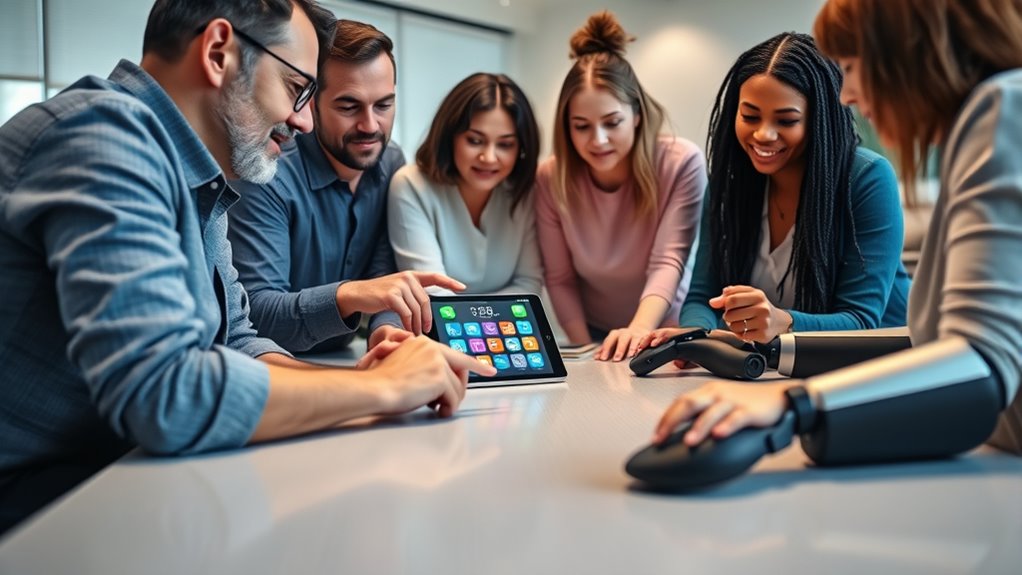
To effectively match assistive technologies to individual needs, you must first clearly identify the specific challenges and goals of the user. Conducting an assistive tech assessment helps you understand their daily routines, physical and cognitive abilities, and personal preferences. This process guarantees personalized device selection, increasing the likelihood of success. Consider these factors: – The user’s primary activities and tasks they want to improve – Any physical or cognitive limitations impacting device use – The environment where the technology will be used Mindfulness techniques can also be integrated into the assessment to better understand the user’s emotional and mental state, ensuring a comprehensive approach to device selection.
Hands-On Practice With Common Assistive Technologies
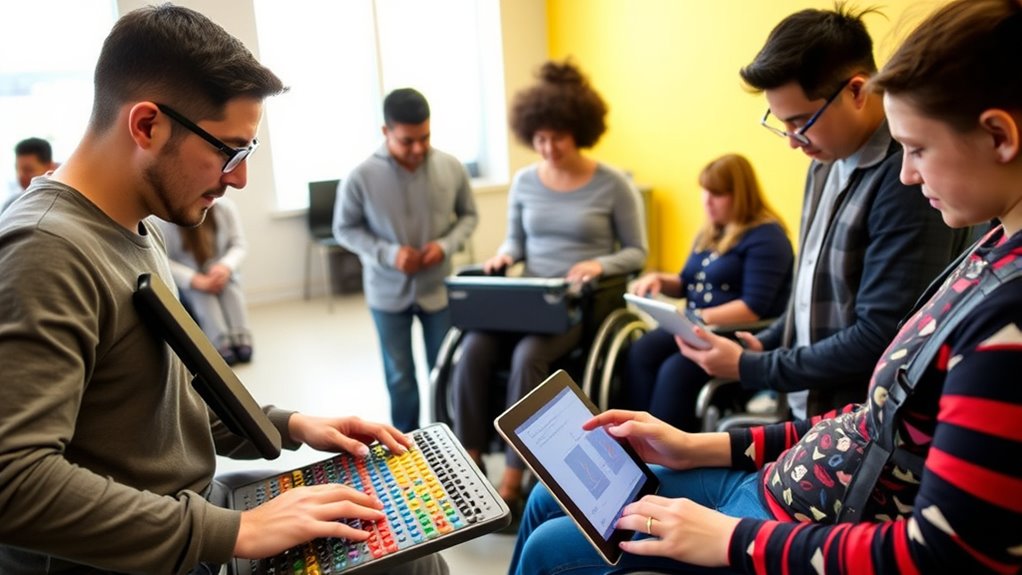
Hands-on practice with common assistive technologies is essential to understanding how these devices function and how users interact with them. Engaging directly helps you grasp the importance of sensory integration, which guarantees devices work seamlessly with a person’s sensory needs. For example, trying out adaptive switches or communication aids reveals how users process inputs and respond effectively. Additionally, experimenting with environmental modifications—like adjusting lighting or adding tactile cues—shows how these changes can enhance device performance and user comfort. This practical experience clarifies the relationship between assistive tech and the environment, empowering you to make informed decisions about device selection and customization. Recognizing the significance of emotional support in assistive technology use can also improve user outcomes and acceptance. Ultimately, hands-on practice deepens your understanding of assistive technology’s role in improving independence.
Staying Informed on Latest Trends and Innovations
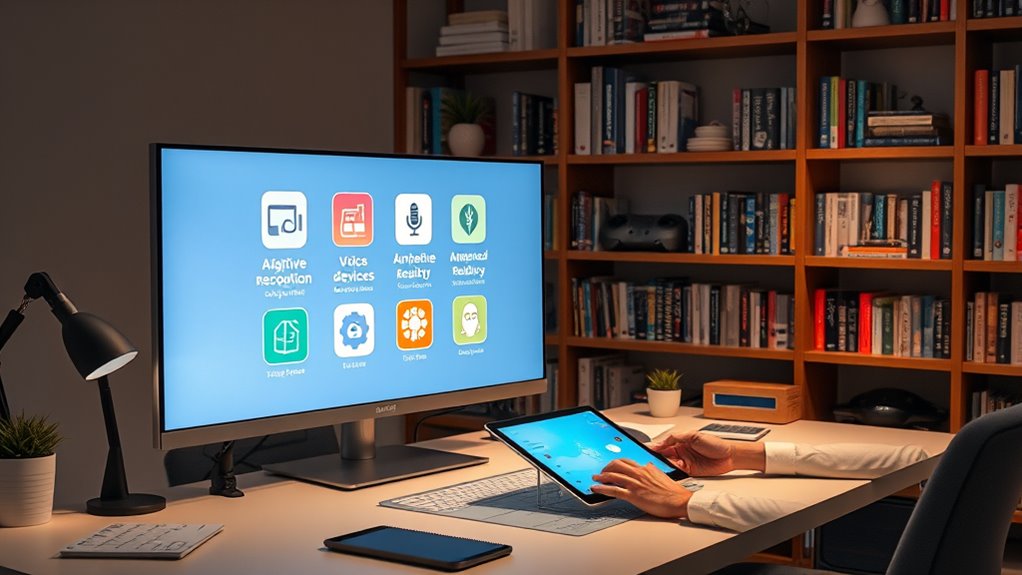
Staying informed about the latest trends and innovations in assistive technology is crucial for providing the most effective support. To keep up, you should regularly explore sources like industry blogs, attend webinars, and join online communities. These channels reveal emerging innovations and help you understand how new assistive tech startups are shaping the field. You’ll see trends such as AI-powered devices, wearable tech, and smart home integrations gaining momentum. Additionally, understanding emergency preparedness essentials can enhance your ability to adapt assistive solutions for various crises and ensure safety in unpredictable situations.
- Discover new startups developing groundbreaking solutions
- Follow industry leaders sharing insights and updates
- Participate in conferences showcasing emerging innovation
Building Skills for Implementation and Support

Developing strong skills for implementation and support is essential to guarantee assistive technologies effectively meet users’ needs. You must master assistive tech troubleshooting to quickly identify and resolve issues, minimizing user frustration. Equally important are user training techniques that ensure users understand how to operate devices confidently and independently. Practice clear communication, patience, and tailored instruction to maximize learning. Staying calm during troubleshooting helps build trust and confidence. Continuous learning about new features or updates improves your support capabilities. By honing these skills, you ensure smooth integration of assistive tech into users’ lives, fostering independence and satisfaction. Additionally, understanding the diverse range of content available, such as various types of media and communication methods, can enhance your ability to support different user needs. Remember, effective implementation and ongoing support are key to the long-term success of any assistive technology solution.
Frequently Asked Questions
How Do I Choose the Right Assistive Technology for Specific Disabilities?
To select the right assistive technology, start by understanding the specific disability and evaluate how device customization can address those needs. Consider features that enhance usability for the user, and guarantee the device is adaptable. You should also provide thorough user training to maximize effectiveness. Testing different options and consulting with professionals can help you find a solution that fits perfectly and supports the user’s independence and comfort.
What Funding Options Are Available for Acquiring Assistive Devices?
You might find that funding sources and financial assistance programs make acquiring assistive devices more accessible. Many options include government grants, Medicaid, Medicare, and state-funded programs. Nonprofits and charities also provide financial aid or equipment donations. Check with local agencies or disability organizations to explore these opportunities. By actively researching and applying for these funding sources, you can reduce costs and guarantee you get the assistive tech you need to improve your daily life.
How Can I Train Others to Use Assistive Technologies Effectively?
To train others effectively on assistive technologies, focus on engaging training strategies that cater to different learning styles. Use hands-on practice, real-life scenarios, and visual aids to boost user engagement. Encourage questions and feedback to tailor the training to individual needs. Keep sessions interactive and patient, allowing learners to build confidence. By fostering a supportive environment, you help users master assistive tools, ensuring they gain independence and confidence.
What Are Common Challenges in Implementing Assistive Tech in Schools or Workplaces?
Implementing assistive tech is like fitting puzzle pieces together, but you might face hurdles with technology integration and user acceptance. Resistance to change, lack of training, or limited resources can slow progress. You need to foster a supportive environment, involve users early, and provide ongoing support. When everyone understands the benefits and feels confident, technology integration becomes smoother, and user acceptance increases, making your efforts more successful.
How Do Assistive Technologies Evolve With User Needs Over Time?
Assistive technologies evolve with your needs through ongoing technology adaptation and user-centered design. As your skills and challenges change, developers update features or create new tools tailored to your preferences. You can provide feedback, ensuring the tech stays relevant and effective. This continuous process helps the assistive technology grow with you, improving accessibility, independence, and overall experience over time.
Conclusion
By mastering assistive tech in just 7 days, you’re opening doors to better support for millions. Did you know that over 1 billion people worldwide rely on some form of assistive technology? With your new skills, you’ll be equipped to make a real difference, improving lives and fostering independence. Keep learning and stay updated—your expertise can transform challenges into empowering solutions. The journey from beginner to pro starts now!
